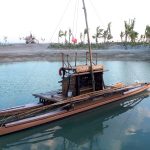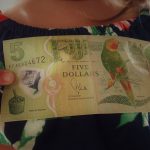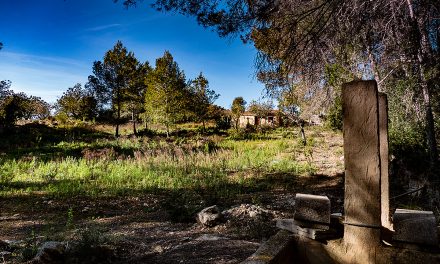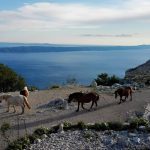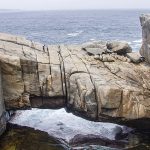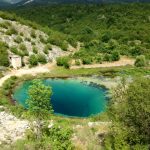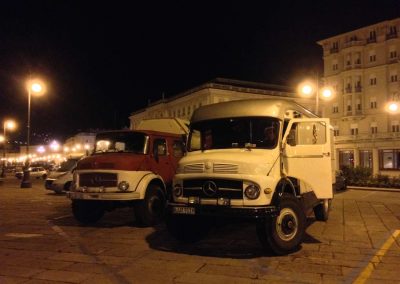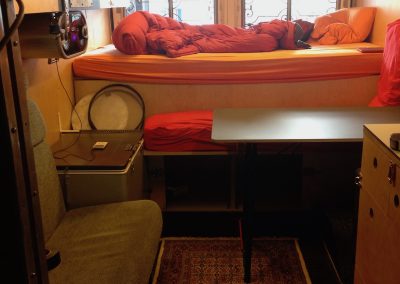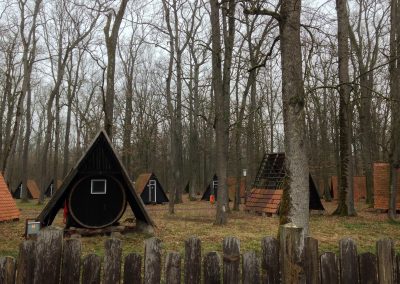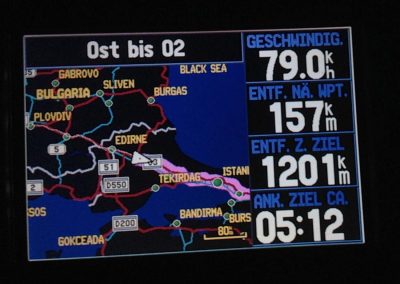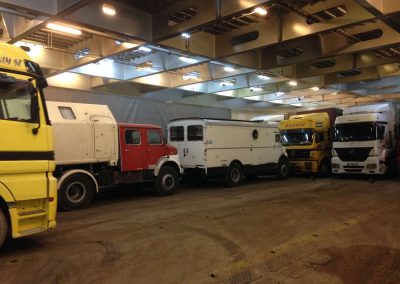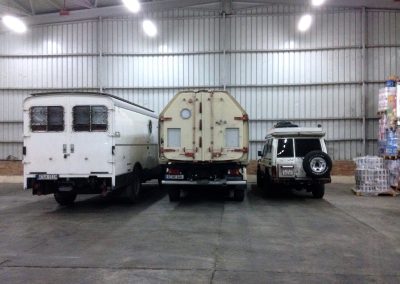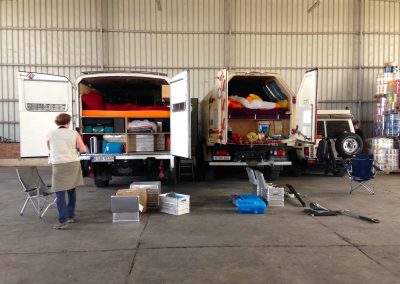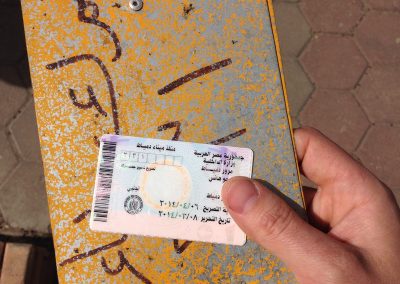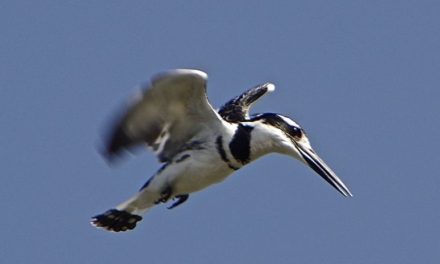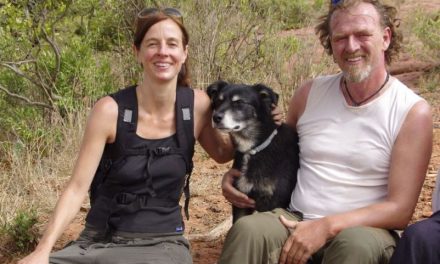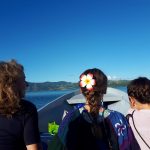
Fähre und Einreise nach Ägypten
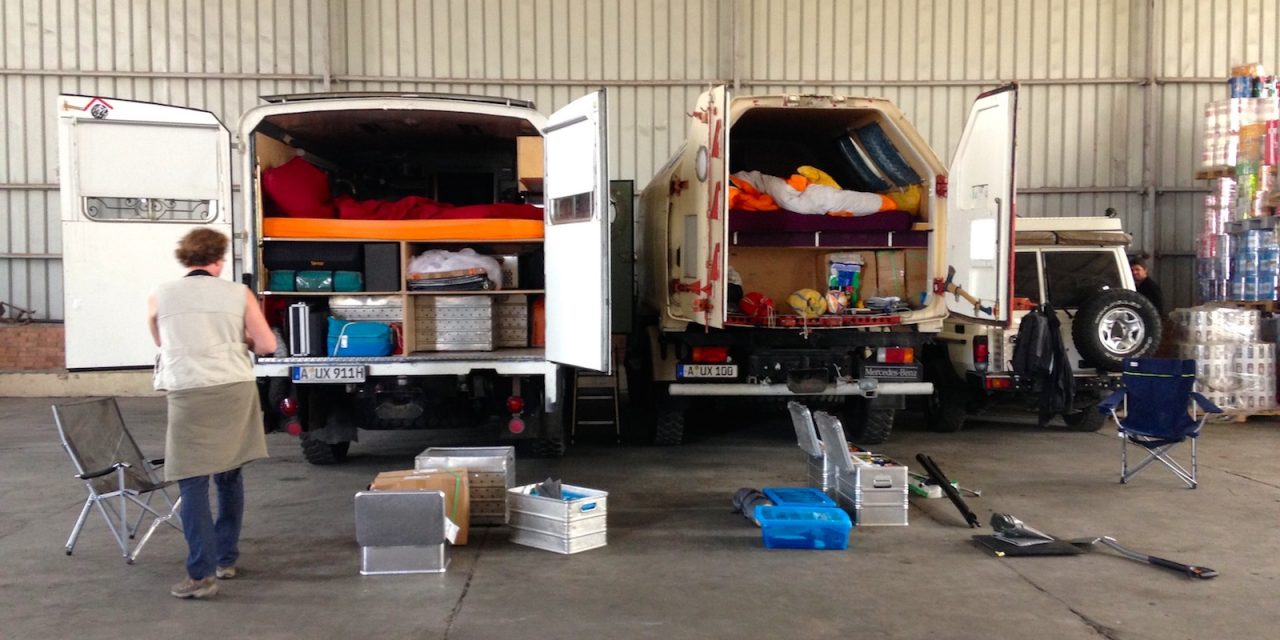
Über Land
Der einzig mögliche Reiseweg mit dem LKW nach Ägypten ist derzeit (Stand März 2014) mit der türkischen Gesellschaft UNRORO http://unroro.com.tr von Iskenderun (Türkei) nach Damietta im Nildelta.
Da diese Fährgesellschaft auch eine tägliche Verbindung von Trieste nach Mersin anbietet, sind wir zunächst nach Italien. In Trieste erwartete uns aber eine unüberschaubare Anzahl türkischer LKWs und es war nicht klar, ob wir am folgenden Tag mitfahren hätten können.
Und so frisch losgefahren, wollten wir nicht erstmal ein paar Tage auf dem Ladehof campen,
also auf durch den Balkan. Am selben Tag erreichten wir in Kroatien noch ein pittoreskes Fass-Hotel kurz vor der serbischen Grenze (geöffnet April-Okt.). Den folgenden Tag durchquerten wir Serbien auf der Autobahn. Es hat sich zwar schon viel getan, seit meiner letzten Durchfahrt (damals Richtung Indien), aber es gibt immer noch sehr viele triste Anblicke. Wer allerdings auf morbiden mittelalterlichen Charme steht, ist hier bestens bedient.
Belgrad ist äusserst lebendig und es gibt noch raue Mengen sozialistischer Architektur zu sehen. Bulgarien wirkte dann schon wieder wesentlich aufgeräumter und eine nagelneue OMV-Tankstelle hinter der Grenze verwöhnte uns mit Dusche, Internet und lecker Cappucino.
Erst in der Türkei versorgten wir uns mit Landeswährung, bis dahin reichte stets die EC-Karte für Autobahngebühren/Vignetten und Tankstellenbesuche.
An der ersten türkischen Autobahnmautstation steht links im Hintergrund ein unscheinbares weisses Gebäude. Dort bekommt man, wenn man zu Fuss die Gegenspur überquert in einem als Bank ausgewiesenen Büro, einen Sticker mit Funkchip. Für unsere Durchquerung der Türkei haben wir dort dann je Laster etwa 30 Euro gezahlt. Moderat, verglichen mit Europa, respektive Österreich…
In Iskenderun angekommen, haben wir gleich die erste Ausfahrt genommen, die uns direkt zum Hafen hinunter führte. Nach Einfahrt in das Hafengelände ist ein Verlassen wohl problematisch. Das hat uns aber nicht betroffen, da wir direkt vor dem Hafenbüro (Mit imbiss-Kiosk) übernachtet haben. Wir kamen Freitag Abend früh genug an, um auch noch eine der sechs Doppelkabinen zu ergattern. Alternativ kann man per Flieger über Alexandria nach Damietta gelangen. Die Leute vor Ort waren ausnehmend freundlich und bemüht. Pro LKW hat das Ticket dann mit 900 US$ zu Buche geschlagen.
Verladen wurden wir um 22 Uhr und abgelegt hat die Fähre dann etwa gegen 1:30 Uhr.Mit zehn türkischen und jordanischen Truckern haben wir dann inkl. Zwischenstopp in Haifa, ziemlich genau drei Tage auf dem Schiff verbracht. Im Gemeinschaftsraum lief türkisches Fernsehen und man konnte sich aus einem Kühlschrank mit Marmeladen, Feta und Oliven bedienen, bzw. sich einen Tee, oder Nescafe. Um hak 12 und um 18 Uhr gab es Essen aus der Kantine.
Vor Damietta lagen wir dann erstmal 14 Stunden um dann morgens um 4 Uhr anzulegen.
Eine Agentur hat für alle Trucker die Einreise-Visa organisiert. (15+5 US$) Unsere LKW mussten wir in einem Lagerhaus des Zolls unterstellen. Wir haben in der Nähe dann im Hotel Casablanca eingecheckt. Insgesamt hat der bürokratische Wahnsinn dann 4 Tage plus einem Feiertag gedauert. Die Angaben im Netz lagen bei 1,5-14 Tage, ein mittlerer Wert also.
Unser „Fixer“ (Problemlöser) Mohamed war ein fitter und superfreundlicher Kerl.
Seine Kosten beliefen sich auf die Hälfte der insgesamt 500 US$, wobei wir angesichts der
bürokratischen Wege und Wirrnisse unbedingt empfehlen würden solche Dienstleister in Anspruch zu nehmen. Insgesamt hinterliessen die Vorgänge aber einen geordneten und weniger korrupten Eindruck bei uns, als wir erwartet hätten. (Im Vergleich zum Beispiel zu Tunesien.) Mit ägyptischen Nummernschildern und Führerscheinen ausgestattet konnten wir dann also los, Richtung Rotes Meer.
Mit dem Hund im Flugzeug
Da wir unser geliebtes Haustier, den Ossie-Shepard „Mafioso“ nicht mit auf die Fähre nehmen konnten, sind unsere Frauen mit dem Flieger von München nach Hurghada gereist.
Die Lufthansa, bzw. Tochtergesellschaft Condor hat einen guten Ruf in Sachen Tiertransporte. Es lief auch alles freundlichst und problemlos über die Bühne. Die Beruhigungsmittel hatten wir vorher angetestet und den Wassenapf in der IATA-zertifizierten Flugbox dann mit Eiwürfel gefüllt, da weniger verschüttet wird und das Eis auch schön kühlt.
Warten am Roten Meer
Die Gegend von Hurghada gilt als ausgesprochene Touristengegend. Im nördlichen El Gouna findet sich ein 6 Sterne-Haus mit dem Namen „Maisen Bleue“. Es umfasst lediglich 10 „Zimmer“ und ist ein Gesamtkunstwerk. Feinste Barockmöbel und Tapisserien, riesige Lüster und tolle Kunstwerke zieren das palastartige Gebäude direkt am Strand. Eine kleine Privatbucht und ein sehr schöner Pool runden das ganze nach aussen ab. Entsprechend der Preis: 400 €/Nacht inkl.Frühstück (das aber legendär ist.)
Die Tourismusbranche leidet seit vier Jahren extrem unter den politischen Unruhen und dem damit Verbundenen Besucherrückgang. Die kürzlich verhängte Reisewarnung des Auswärtigen Amtes entschärft die Situation natürlich nicht.
Leaving germany with our two 7,5 ton trucks, we had two options in mind to make our way to Iskenderun, which is currently the only port to offer a RORO Ferry (Roll on Roll off) connection to Egypt by a company called UNRORO (http://unroro.com.tr), at the same time being the only safe and realistically drivable route (March 2014) to Egypt.
We could either drive to Trieste and take another UNRORO ferry to Turkey or drive overland to Iskenderun. Since a huge amount of trucks had lined up for the Trieste ferry, and it wasn´t clear whether we would get on that ferry any time soon, we decided to drive.
Our route took us through Austria, Slovenia, Croatia, Serbia, Bulgaria to then enter Turkey, where we continued via Istanbul to Iskenderun on mostly well maintained highways. The first time we changed currency was in Turkey. Up to that point we were either still able to pay with euros, even if there was a different local currency (Slovenia/Croatia) or we could always pay by card (Credit/Debit).
The petrol stations along the way where well kept, the most impressive one being an Austrian franchise OMV Station
just as we crossed into Bulgaria, which offered free Wifi, had a great selection of goods and tasty dishes as well as my favourite belgium Beer „Leffe Blonde“, which to my surprise was restocked immediatley after I emptied the shelf. They also had a shower on offer for us, free of charge.
Until Turkey, with the exception of Austria, we hadn´t needed to buy any special toll machines or stickers for our trucks. We just paid at a few toll gates which were affordable, few, and far in between. Travelling with a bigger truck say above 3,5 tonnes which has been converted to a mobile home, try to always opt for the car lanes anyhow, whether at a toll gate or border post. Mobile homes mostly fall into a more favourable category than heavy trucks.
Although we had our Garmins on duty, we didnt have detailed map material for geographical europe, so we were mostly following the road signs. Except for the detour around Sofia, and some parts in Turkey where it feels like there is an indication for the sought after city only once every 500km, it is mostly quite easy to find your way. If in doubt just follow the big trucks often equipped with TIR signs. They will dodge the cities and on this route are mostly going towards Turkey.
Once we left Bulgaria, which was probably the warmest goodbye ever on a border post with pictures being taken and half the staff gathering to check out our trucks, we entered Turkey which was an equally friendly yet more sober welcome. The boarder post is brand new, and empty. Entering Turkey we barely had to get out of our trucks.
Shortly after we cleared the border, we reached the first turkish highway. Note that you need to buy a sticker with an RFID chip in order to pass through the automated toll gates on the highways. This sticker can be obtained at the first toll gate just after the border where you can park your car on the right hand side just before the gate (no official parking). In our case there were already quite a few trucks parked there because there is a weighing station right behind the toll gate which truck lined up for.
You have to cross to the other side of the highway by foot where you will find a small office inside a white building which also
seems to be a bank. We paid the equivalent of 30 euros each which covered the entire trip through Turkey. Although the man behind the counter barely spoke english, it is enough to mention your destination and he will issue a suitable sticker. The highways in Turkey are mostly perfect, and were super empty for the most part. You are constantly on high altitude, which meant that it got still pretty cold at night, the record low was a -2C at night.
Once we saw the city of Iskenderun appearing beneath us, as we descended towards it, we took the first exit off the highway which, by eye, should have taken us directly to the harbour, and it did. Once you take the off ramp, take a left onto a longish fenced road that runs parallel to the highway. The second entrance on your right is the harbour entrance, its rather inconspicuous. We drove right up to the security checkpoint which seemed to be slightly overwhelmed keeping track of the traffic entering and leaving the small port.
The UNRORO office is in the first of the two one storey buildings you can see right from the entrance, to the right
of a big scale for trucks.
We parked our trucks right outside the office, and a port manager directed us to the UNRORO offices. We were welcomed by name (we had spoken with them before via phone and email), and everyone was very friendly, and the hirachies were quickly established. Here is our account manager, here is our general manager etc. One of the guys spoke good english, the rest none to very little.
Since we were at the beginning of our trip, we were still „thee of little faith“, westerners that dont fully trust the wonderful ways of oriental/african management. I am mentioning this, because at this point you start getting contradictory information about departure times, modes of travel, and you start giving your passport away to someone you just met. It is normal proceedings of course, but at first a little unsettling, unless you have already visited countries with unorthodox border or customs proceedings in languages you dont understand.
The next day we got our Tickets together with a confirmation that we would be able to travel aboard the ferry in one of 6 double cabins. Before we were told we would have to catch a plane, which would have been included in the ferry package. We paid 900USD in total, each, cash. This included only the ferry trip for our trucks and us.
Everything in the harbour is very easy going. So we were without anyone asking even once, allowed to stay right in front of the office and camp out. There is also a small snack/sandwich shop there.
So the guys at UNRORO of course do this trip every week, and they know exactly what they are doing, but if and when the ferry departs seems to depend on a number of factors, mostly apparently on getting a slot in the port of Haifa (stopover), where things go according to strict schedules, unlike in Damietta, and Iskenderun. About a day before departure we had a good idea when the ship would leave, and so it did on Sunday at 01:20 leave Iskenderun. The trip took a good three days, although we spent about 24 hours waiting around in front of or inside harbours. The cabins are spacious, have a hot shower and there is some feta cheese, olives, and lots of jam and bread ready for snacking in the mess, as well as instant coffee and tea. Twice a day we got warm food from the cantine.
Once in Damietta, we anchored at about 03:30 on tuesday morning, the trucks got unloaded and the madness started. First some officials want to see your passport, and this will continue from here on out, everyone that remotely has business with the authorities will want to have a look at your car, your passport or ask you where you from or where you are going. There is the shipping company that handles the customs for all trucks and passengers on board to whom you give your passports in order to get your egyptian entry stamp/visa, we gave them 20 USD on the spot together with our passports. It seemed shady, two people arrived in a car and hastily asked for our passports and the money. But there is a system behind it all. Normal proceedings. Soon after we got our visas, we were asked to follow the same guys to a warehouse at another site in the harbour were our trucks would be sitting until cleared by customs. The warehouse is operated by a private person. On the spot we were asked to hand over the keys to our trucks. And even as far as this might have been standard proceedings, we were not willing to hand over the keys to the back of our trucks with all our treasures lying bare. So we insisted to be on location when customs want to search the trucks. So we left only the keys to the front of the trucks.
Either way, with or without key, they will search the car again and again. A fellow traveller, Lukas from Switzerland, with his Landcruiser, handed his keys over, and noted that his car had been searched without him present, only to be searched again once we were present. So, personally I reckon, no need to hand over your keys. The searches are lax and its all a question of negotiation it seemed.
Here began our 5 day wait for the clearnce of the cars. The following day we were introduced to our fixer, Mohamed, a nice guy, very friendly, and competent who spoke good english. He drew up a clear list of all the costs involved upfront and explained the procedures. All in all it would cost us about 500USD to get our cars out of customs, the bigger part of the fee going to our fixer Mohamed. Having followed and witnessed quite a bit of the process, it seemed next to impossible to do it yourself. With no clue where to go, which forms to fill out, whom to speak to and whom to bribe, I imagined myself being stuck there for weeks if not months, eventually not even flinching at the sight of the ports public toilets. Apparently once you exited the port, the only time you could legally enter again is to pick up your cars. They dont care that in the mean time you personally have to enter the port to sign a few papers and stand before officials. Even our fixer had to pay a cop to travel in our car to pass the harbour checkpoint more easily. Yet he still had to bribe a couple of people. Egyptians suffer a great deal under this corrupt system, while some get rich.
First we stayed at a reasonable but rather expensive hotel called Casablanca near the port, then we moved to a better place in Ras El Bar, both in terms of the establishment and location, same price. If you are going to spend more than a few days, its worth staying in Ras El Bar. Its by the Sea and has some nice restaurant and a beach front.
So after some uncertainty we finally got our cars back, 5 days later (including one holiday), after very lax custom searches and negotiations of our fixer in order for us not having to declare basically anything we were carrying with us. With our Egyption number plates and licenses we were off.
Panorama „Maison Bleue“ innen




